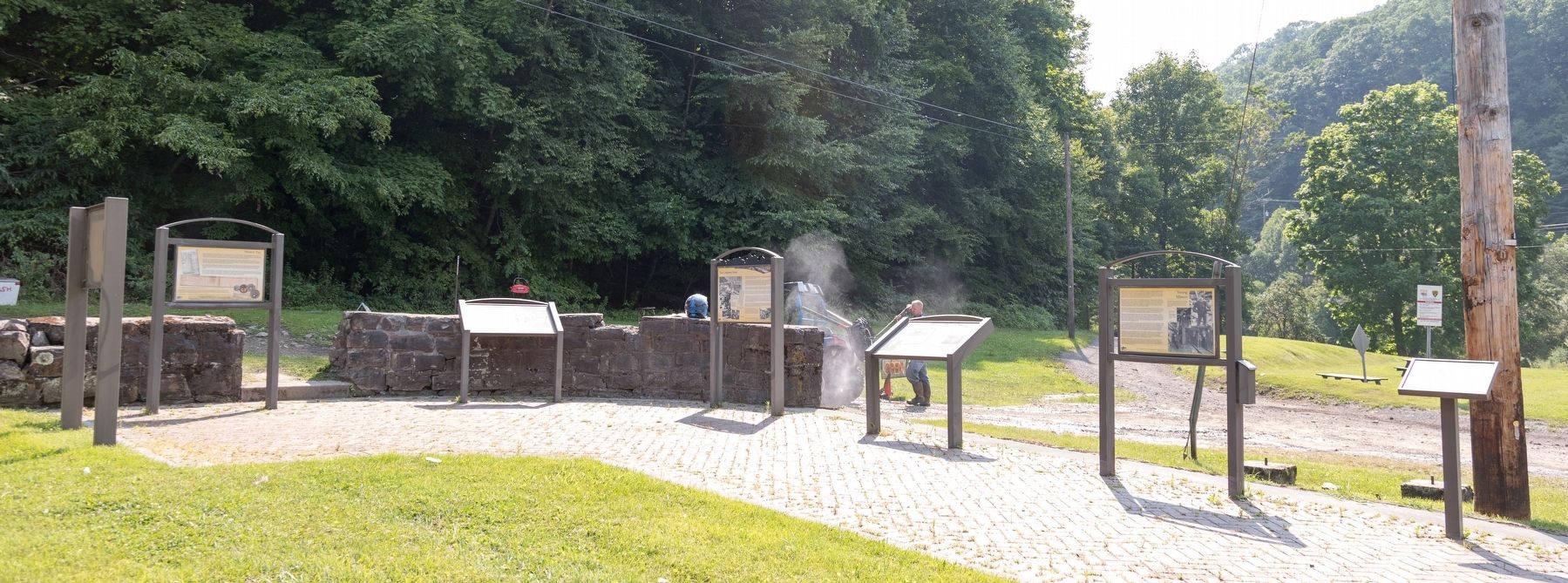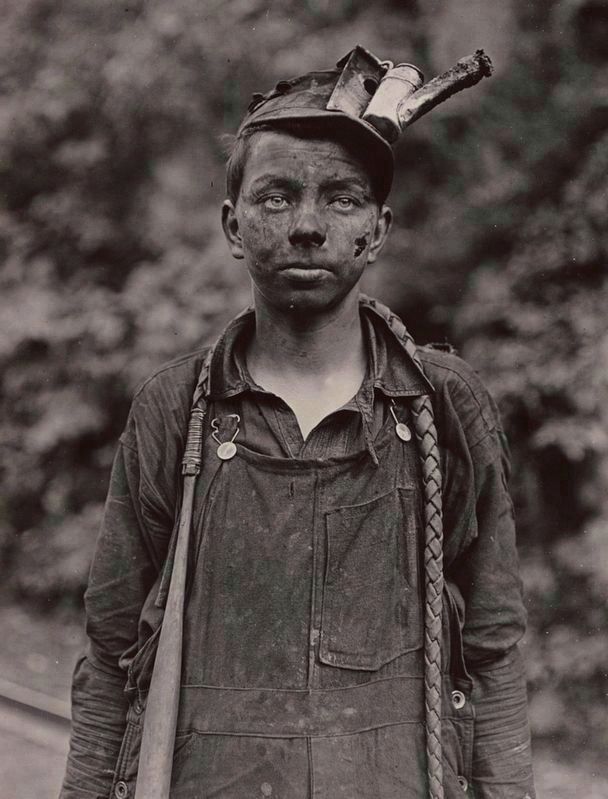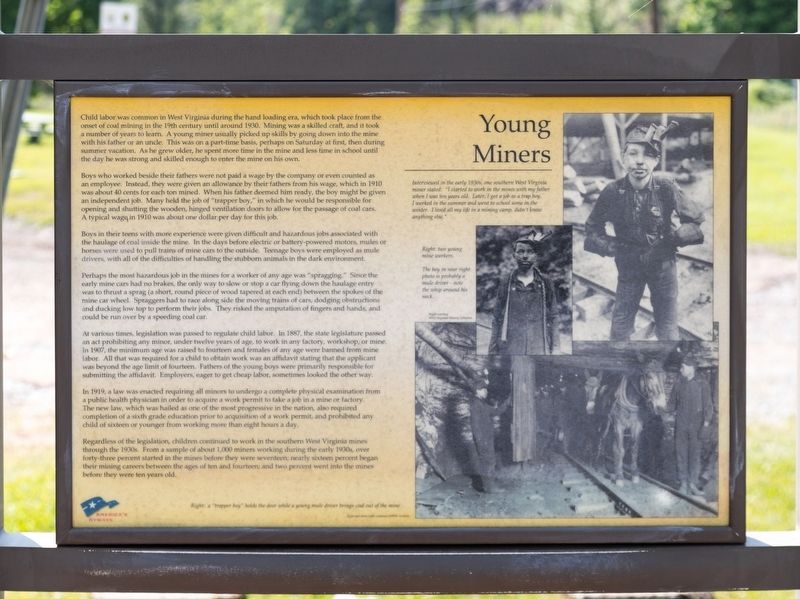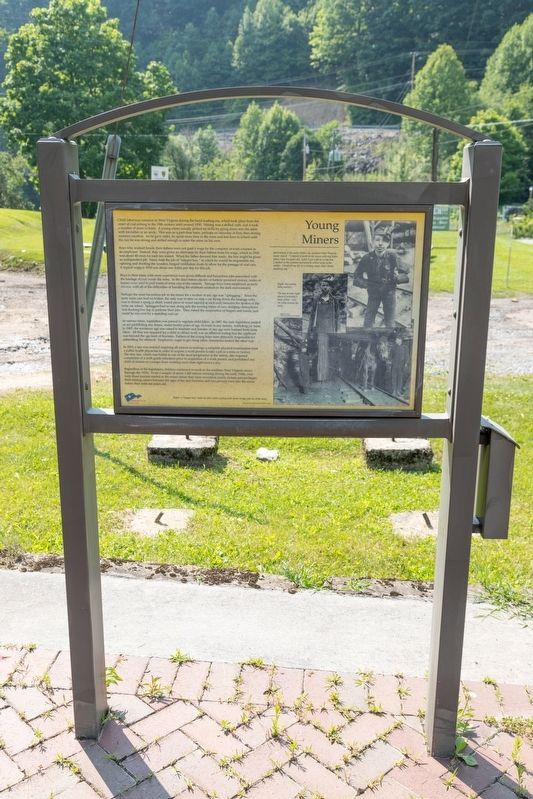Ashland in McDowell County, West Virginia — The American South (Appalachia)
Young Miners
— National Coal Heritage Trail —
Boys who worked beside their fathers were not paid a wage by the company or even counted as an employee. Instead, they were given an allowance by their fathers from his wage, which in 1910 was about 40 cents for each ton mined. When his father deemed him ready, the boy might be given an independent job. Many held the job of “trapper boy,” in which he would be responsible for opening and shutting the wooden, hinged ventilation doors to allow for the passage of coal cars. A typical wage in 1910 was about one dollar per day for this job.
Boys in their teens with more experience were given difficult and hazardous jobs associated with the haulage of coal inside the mine. In the days before electric or battery-powered motors, mules or horses were used to pull trains of mine cars to the outside. Teenage boys were employed as mule drivers, with all of the difficulties of handling the stubborn animals in the dark environment.
Perhaps the most hazardous job in the mines for a worker of any age was “spragging.” Since the early mine cars had no brakes, the only way to slow or stop a car flying down the haulage entry was to thrust a sprag (a short, round piece of wood tapered at each end) between the spokes of the mine car wheel. Spraggers had to race along side the moving trains of cars, dodging obstructions and ducking low top to perform their jobs. They risked the amputation of fingers and hands, and could be run over by a speeding coal car. At various times, legislation was passed to regulate child labor. In 1887, the state legislature passed an act prohibiting any minor, under twelve years of age, to work in any factory workshop, or mine. In 1907, the minimum age was raised to fourteen and females of any age were banned from mine labor. All that was required for a child to obtain work was an affidavit stating that the applicant was beyond the age limit of fourteen. Fathers of the young boys were primarily responsible for submitting the affidavit. Employers, eager to get cheap labor, sometimes looked the other way.
In 1919, a law was enacted requiring all minors to undergo a complete physical examination from a public health physician in order to acquire a work permit to take a lob in a mine or factory. The new law, which was hailed as one of the most progressive in the nation, also required completion of a sixth grade education prior to acquisition of a work permit and prohibited any child of sixteen or younger from working more than eight hours a day.
Regardless of the legislation, children continued to work in the southern West Virginia mines through the 1930s. From a sample of about 1,000 miners working during the early 1930s, over forty-three percent started in the mines before they were seventeen; nearly sixteen percent began their mining careers between the ages of ten and fourteen; and two percent went into the mines before they were ten years old.
(sidebar)
Interviewed in the early 1930s, one southern West Virginia miner stated: “I started to work in the mines with my father when I was ten years old. Later, I got a job as a trap boy. I worked in the summer and went to school some in the winter. I lived all my life in a mining camp, didn’t know anything else.
Erected by National Coal Highway Authority and America’s Byways.
Topics. This historical marker is listed in these topic lists: Government & Politics • Industry & Commerce • Natural Resources. A significant historical year for this entry is 1930.
Location. 37° 24.531′

Photographed By J. J. Prats, July 24, 2021
3. National Coal Heritage Area Trail Interpretive Stop, Ashland WV
The sign all the way to the left shown in profile is not a historical marker. It is the sign for the Interpretive stop. The small sign on a single post all the way on the right has a map of the Coal Heritage Trail and lists points of interest along the trail.
This historical marker is the left-most upright sign.
Other nearby markers. At least 8 other markers are within 7 miles of this marker, measured as the crow flies. Ashland Coal and Coke (here, next to this marker); The Company Store (here, next to this marker); No Work Tomorrow (a few steps from this marker); Miners’ Pay (a few steps from this marker); Elizabeth Simpson Drewry (approx. 4.6 miles away); Bramwell (approx. 6.1 miles away); Mill Creek Coal & Coke Co. (approx. 6.1 miles away); The Coal Barons (approx. 6.2 miles away). Touch for a list and map of all markers in Ashland.
More about this marker. This interpretive panel contains three photographs captioned, top to bottom:
- Young miner
- The boy [in this] photo is probably a mule driver – note the whip around his neck.
- A “trapper boy” holds the door while a young mule driver brings coal out of the mine

Lewis Hine via U.S. National Archives, 1908
4. Young Driver in Mine, Brown, W. Va.
This is the second photo shown on the marker. Full caption as written by the photographer: Young Driver in Mine. Has been driving one year. 7 A.M. to 5:30 P.M daily Brown Mine, Brown W. Va. He is wearing a oil lamp on his head, the wick, pointing right, is extinguished and no longer smoking.
Credits. This page was last revised on August 6, 2021. It was originally submitted on August 6, 2021, by J. J. Prats of Powell, Ohio. This page has been viewed 158 times since then and 11 times this year. Photos: 1, 2, 3, 4. submitted on August 6, 2021, by J. J. Prats of Powell, Ohio.

